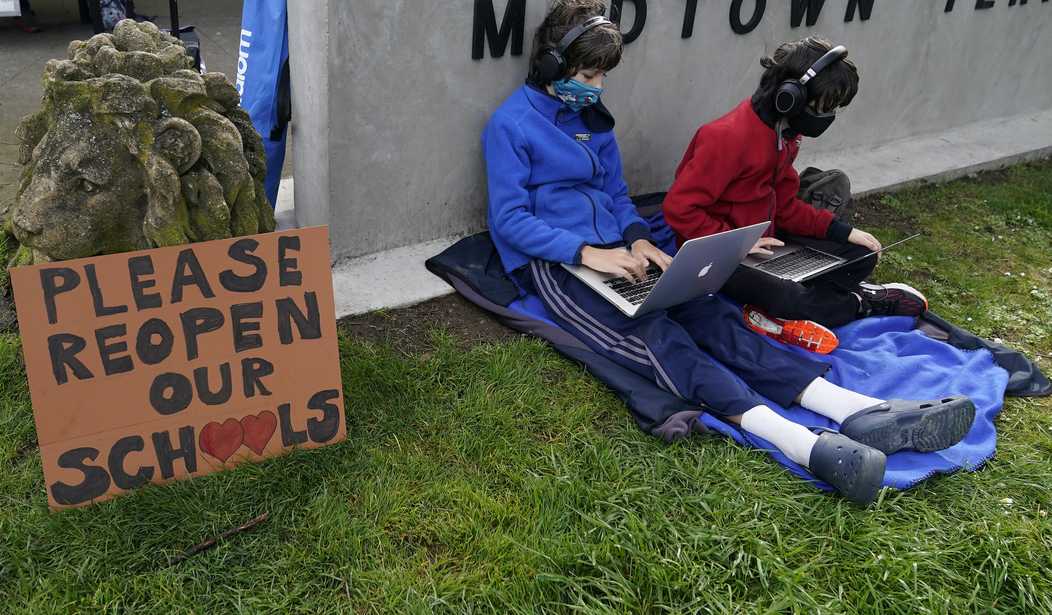You’re reading that headline and thinking, “Wait, what was Biden’s goal again?” Good question. It’s hard to recall because it’s changed so often. Originally the goal was to have nearly all schools open by the end of his first 100 days. At some point after hearing that the teachers unions must have had a word with him because soon Jen Psaki was claiming that the goal was to have a majority of schools open one day a week (or more, ideally). That bar was pathetically low even by Biden standards, though, so the White House recalibrated again, with Biden himself saying in February that the goal was to have a majority of middle and elementary schools open five days a week.
They’ve now reached that, the AP reports today. But there’s a catch.
The survey, conducted in March by the Education Department and released Thursday, found that 54 percent of public schools below high school were offering full-time classroom learning to any student who wanted it. It marks steady progress since January, when the figure was 46 percent.
Forty-six percent when he took office, 54 percent today. In other words, 85 percent of school reopenings had already happened before the end of his first two weeks as president. “It must be nice to set a goal that is already achieved when you enter office, do everything possible to reverse progress and then get an attaboy from the media. FFS,” sniffs Rory Cooper.
An eight-point increase is what Sleepy Joe gets for letting the unions write your scientific guidance, I guess.
As you might imagine, there are disparities between red states and blue states on school reopenings. Insane disparities in some cases:
Progress has been equally uneven based on geography, the survey found. Half of all students in the South and Midwest were learning entirely in-person in March, compared to less than 20 percent in the West and Northeast. Still, the Northeast saw the largest gains, with Connecticut doubling its share of fourth grade students learning fully in-person, from 17 percent to 35 percent.
Wyoming had the largest share of fourth grade students attending full-time in the classroom, at 94 percent, while California had the lowest, with 5 percent. Schools in rural areas were the most likely to be opened, while schools in cities have been the slowest to reopen.
Five percent. It’s the overcautious blue states that are the biggest laggards — that’s the bad news. The good news is that, with a Democrat in the White House, the political leadership in blue states should be more susceptible to pressure from Washington to reopen schools more quickly.
So … where is that pressure? Watch education secretary Miguel Cardona asked this morning whether all schools should be open and punting on the subject, insisting that one size doesn’t fit all.
Despite overwhelming data proving schools are amongst the safest places to avoid catching Covid, Biden’s education secretary, @SecCardona, refuses to say they should be open pic.twitter.com/HzmS2MBtAj
— Tom Elliott (@tomselliott) May 6, 2021
One point Cardona makes that sometimes gets overlooked in the reopening debate is that some parents, especially minorities, are “hesitant” to send their kids back to school. Righty activists are gung ho to get kids back in the classroom, fearing that the damage to their development from remote learning may be irreversible, and those fears are well founded. But they’re not universal. For some moms and dads, the greater fear is that their kids will pick up the virus in school and bring it home, where it’ll lay waste to the family. For others, getting the equipment needed to connect remotely for class is too much of a financial or technological burden. Still others have enlisted their kids to help support the family in one way or another amid the pandemic economic crash. Result: More children than you may think aren’t learning at all. Not even remotely.
By one estimate, three million students nationwide, roughly the school-age population of Florida, stopped going to classes, virtual or in person, after the pandemic began.
A disproportionate number of those disengaged students are lower-income Black, Latino and Native American children who have struggled to keep up in classrooms that are partly or fully remote, for reasons ranging from poor internet service to needing to support their families by working or caring for siblings. Many are homeless or English language learners. Others whose parents work outside the home have struggled in the absence of adult supervision.
“We do have students who have kind of disappeared,” said Barbara E. Cage, the principal of Oakhurst Intermediate Academy, the school Jordyn attends in Clarksdale, Miss. The district says the number of students with five or more absences since the fall has increased 20 percent over the previous year. “We’re not able to reach them.”
Red America and blue America each have a “holdout” problem to deal with. Red states have a problem with getting their residents to get vaccinated. Blue states have a problem with getting parents and school districts motivated to get kids back to class. Hopefully the fear of school outbreaks among anxious observers will begin to ease once Pfizer’s vaccine is made available to kids 12 and up next week.








Join the conversation as a VIP Member